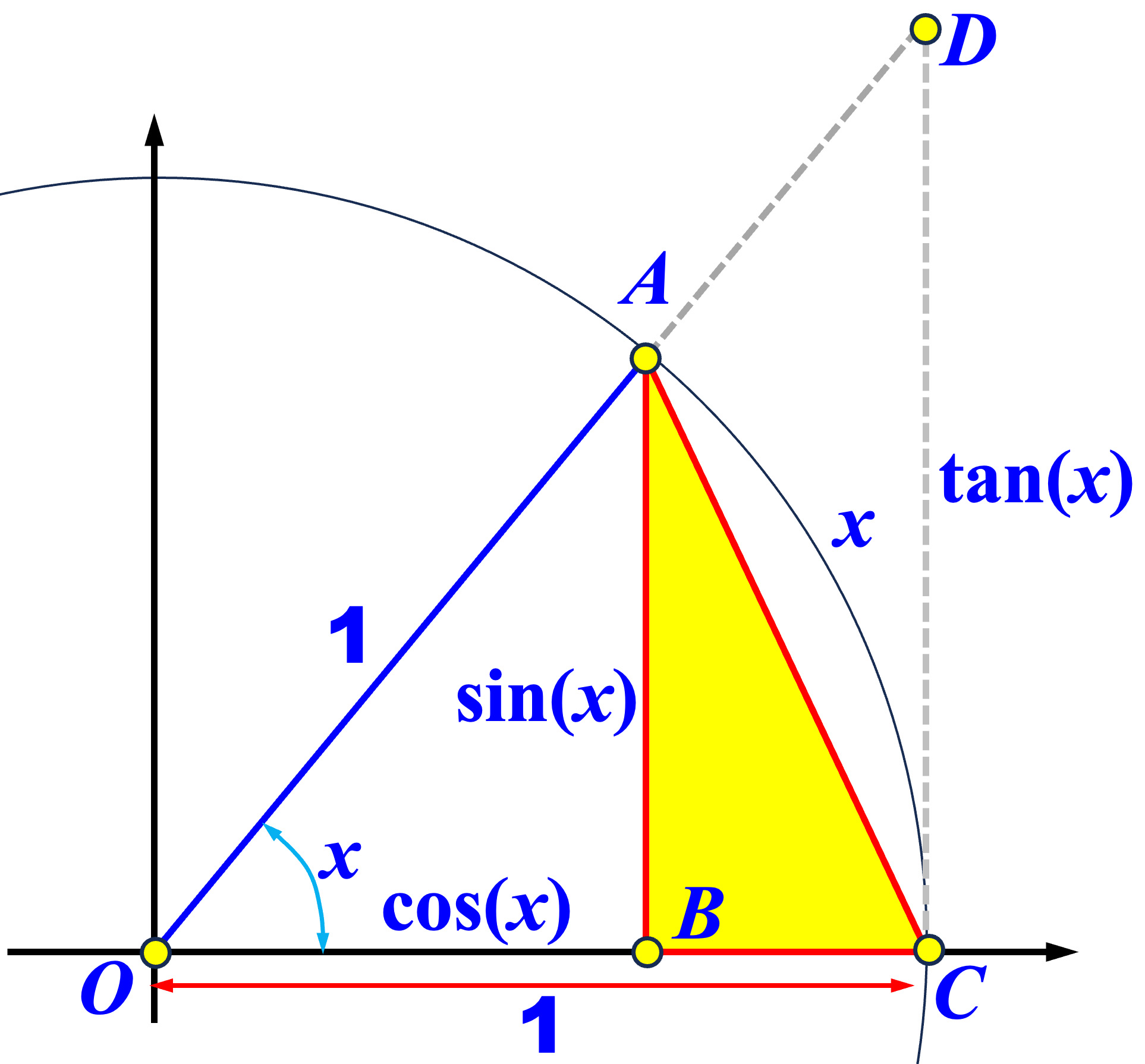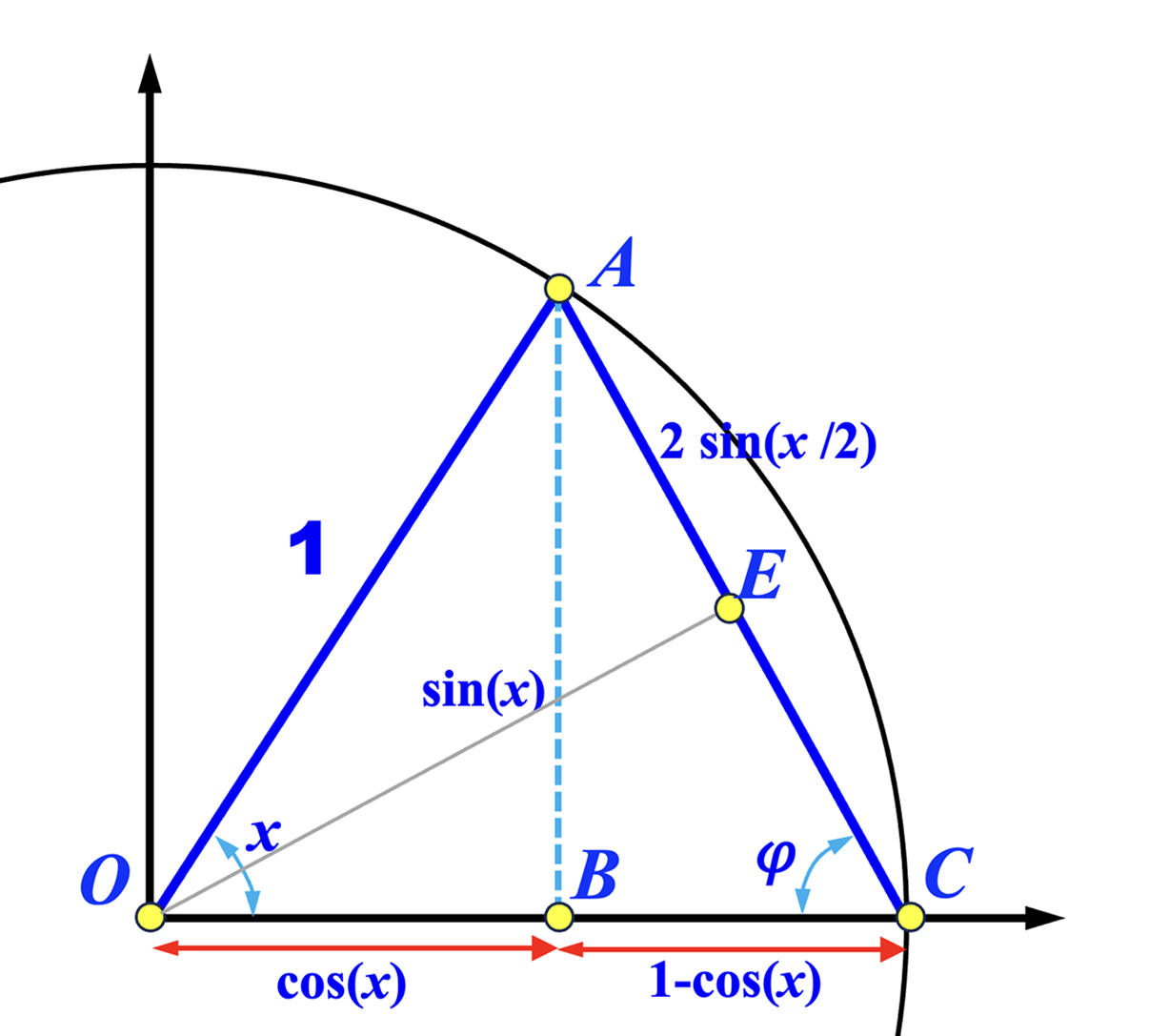A Few Useful Results
Ching-Kuang Shene (冼鏡光), Professor Emeritus
Department of Computer Science
Michigan Technological University
Houghton, MI 49931
USA
Created September 25, 2025
![]()
Ching-Kuang Shene (冼鏡光), Professor Emeritus
Department of Computer Science
Michigan Technological University
Houghton, MI 49931
USA
Created September 25, 2025
![]()
Before we proceed to present you proofs using caluclus,
we need a few more useful results that will be used to prove
the Pythagorean Identity using calculus.
Proof of \( x > \sin(x) \)
We first prove an important property \( x > \sin(x) \)
to be used in computing the derivatives of the sine and cosine functions
without using the Pythagorean Theorem and the Pythagorean Identity.
Let \( O \) be the center of a unit circle and \( \overrightarrow{OC} \) be the x-axis where \( C \) is on the circle (diagram below). Let \( A \) be a point on the circle with \( \angle AOC = x \). Because we are dealing with the limit of \( x \rightarrow 0 \), we may assume that \( x \) is positive and close to 0. The case of a negative \( x \) can be treated similarly. Let \( B \) be the perpendicular foot from \( A \) to the x-axis. From \( \bigtriangleup AOB \) we have \( \overline{OB}=\cos(x) \) and \( \overline{AB} = \sin(x) \). Then, the arc length \( x \) between \( A \) and \( C \) is larger than \( \overline{AC} \), which is the hypotenuse of the right triangle \( \bigtriangleup ABC \) and is larger than the other sides. Therefore, we have \( x > \overline{AC} > \overline{AB} = \sin(x) \).

|
Because \( \sin(x)=\cos\left(\frac{1}{2}\pi - x \right)\), \( \sin(x) \) is also continuous.

|
Recall the weighted AM-GM (arithmetic mean - geometric mean) inequality. Given non-negative \( x \) and \( y \) and a non-negative weight \( 0 \leq \lambda \leq 1 \), the weighted AM-GM inequality means \( \lambda x + (1-\lambda) y \geq x^{\lambda} \cdot y^{1-\lambda} \). For the \( \ln() \) function we have $$ \begin{eqnarray*} \ln( \lambda x + (1-\lambda) y ) &\geq& \ln\left( x^{\lambda} \cdot y^{1-\lambda} \right) \\ &=& \ln\left(x^{\lambda}\right) + \ln\left(y^{1-\lambda} \right) \\ &=& \lambda\ln(x) + (1-\lambda)\ln(y) \end{eqnarray*} $$ This means the natural logarithm function \( \ln() \) is a concave function.
Now, consider the unit circle with center \( O \) at the coordinate origin. The curve of \( \ln() \) passes through the point \( C = (1,0) \) (diagram below). Note that the slope of the tangent of \( \ln() \) at \( C \) is 1 and passes through the south pole \( S = (0,-1) \) of the unit circle. Because the curve of \( \ln() \) is concave, it is below the line \( \overleftrightarrow{CS} \). Furthermore, the curve of \( \ln() \) enters the unit circle from \( C \) and exits the unit circle at a point \( W \). Let the line through \( W \) and perpendicular to \( \overleftrightarrow{OC} \) meet \( \overleftrightarrow{OC} \), \( \overleftrightarrow{SC} \) and the unit circle (again) at \( U \), \( V \) and \( T \), respectively. Consequently, the curve of \( \ln() \) lies completely inside the triangle \( \bigtriangleup CVW \).
-1.jpg)
|
Let \( \varphi = \angle TOU \). Let \( A \) be a point on the unit circle. If \( \theta = \angle AOC > \varphi \), the line through \( A \) and perpendicular to \( \overleftrightarrow{OC} \) does not interset the curve of \( \ln() \) in \( \bigtriangleup CVW \). Hence, we are safe to assume that \( \theta \leq \varphi \). Let the line through \( A \) and perpendicular to \( \overleftrightarrow{OC} \) meeting \( \overleftrightarrow{OC} \), \( \overleftrightarrow{SC} \), the curve of \( \ln() \), \( \overleftrightarrow{WC} \) and the unit circle (again) at \( B \), \( D \), \( E \), \( F \) and \( G \). In this way, we have the following: $$ \begin{eqnarray*} \overline{OB} &=& \cos(\theta) \\ \overline{BC} &=& \overline{BD} = 1-\cos(\theta) \\ \overline{BE} &=& |\ln(\overline{OB})| = |\ln(\cos(\theta))| \end{eqnarray*} $$
The diagram below is a portion of the diagram above. Consider \( \bigtriangleup CVW \). Because \( \bigtriangleup CUW \sim \bigtriangleup CBF \) and \( \bigtriangleup CUV \sim \bigtriangleup CBD \), we have \[ \frac{\overline{UW}}{\overline{UV}} = \frac{\overline{BF}}{\overline{BD}} \] Let \( \rho = \frac{\overline{UW}}{\overline{UV}} \). Note that \( \rho > 1\) is a constant because \( \varphi \) is a constant. Therefore, we have \( \overline{BF} = \rho\cdot\overline{BD} \) and \( \overline{BF} \geq \overline{BE} \geq \overline{BD} \). The following holds: \[ \overline{BF} = \rho\cdot\overline{BD} \geq \overline{BE} \geq \overline{BD} \] Because \( \overline{BD} = 1-\cos(\theta) \), the above becomes \[ \rho(1-\cos(\theta)) \geq | \ln(\cos(\theta) |\geq 1-\cos(\theta) \] Dividing the above by \( \theta \) yeilds \[ \rho\frac{1-\cos(\theta)}{\theta} \geq \frac{| \ln(\cos(\theta) |}{\theta} \geq \frac{1-\cos(\theta)}{\theta} \] Because \( \lim_{x\rightarrow 0}\frac{1-\cos(\theta)}{\theta} = 0 \), we have \[ \lim_{x\rightarrow 0}\frac{|\ln(\cos(\theta))|}{\theta} = 0 \]
-2.jpg)
|
In fact, the absolute value in the above result does not matter because the limit is 0.
Go back to Home Page.